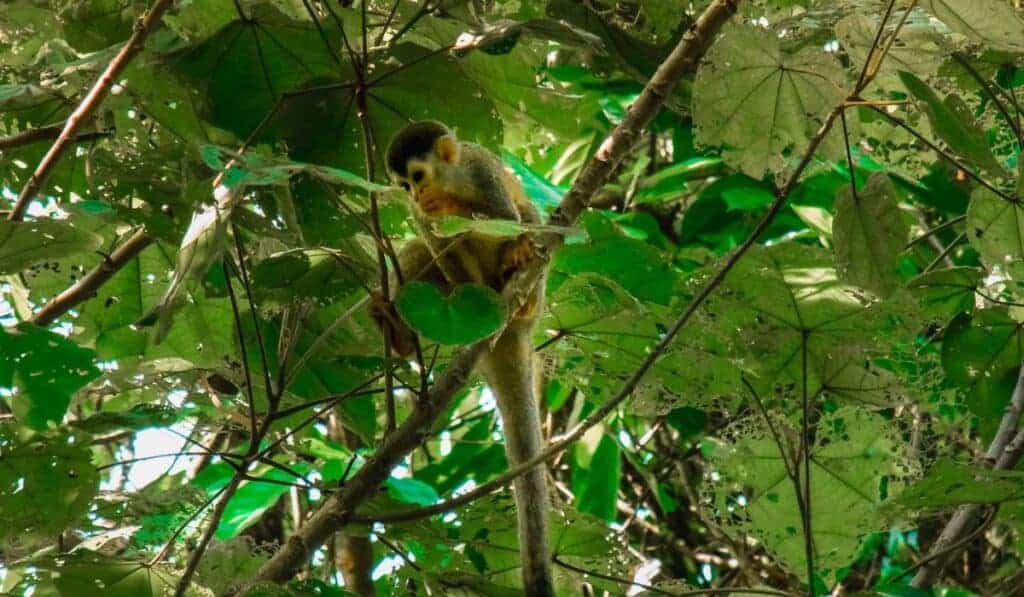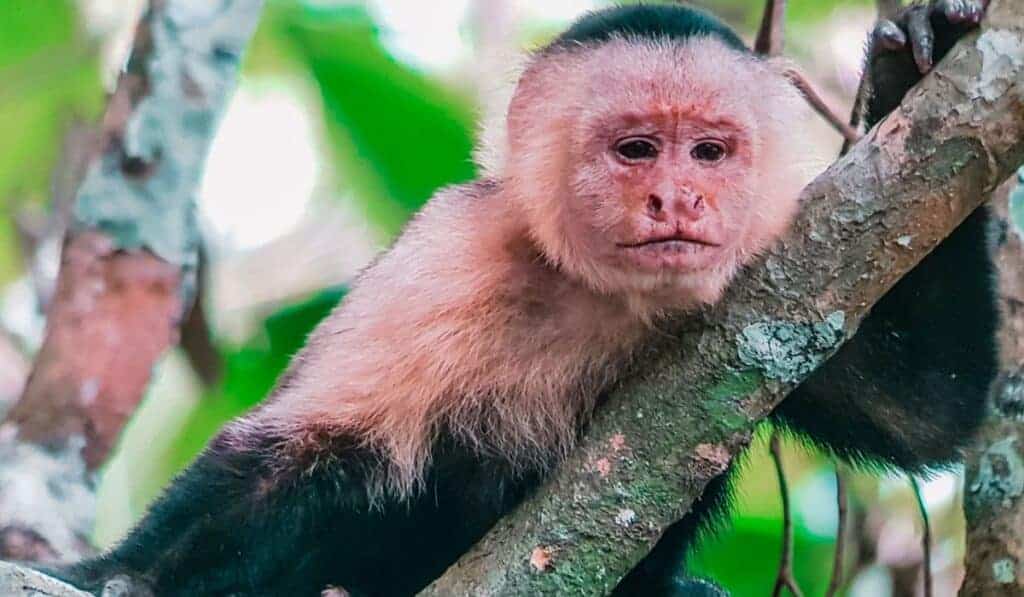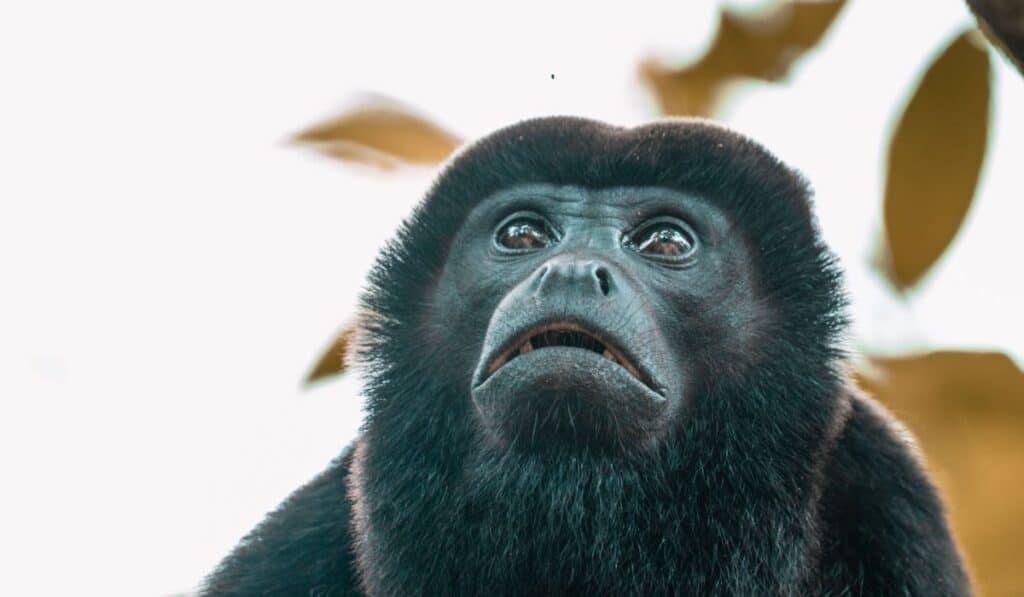Monkeys in Costa Rica: How to See Them Up Close
Disclaimer: This article may contain affiliate links. Clicking on them may earn Costa Rica Vibes a commission, at no extra cost to you. Thank you for your support!
There are four different types of monkeys in Costa Rica that you can see while in the country. Although the monkeys are sometimes high up in the trees, there are a few ways to ensure you spot them.
We have been fortunate enough to travel all over Costa Rica in our several years of living here. We have discovered it is almost guaranteed that you will see monkeys or at least hear them during your travels here.
In this guide, we will go through the different types of monkeys in Costa Rica, national parks where you can spot them, and some other helpful tips.
Types of Monkeys in Costa Rica
There are four types of monkeys you may see in Costa Rica. These are; the Panamanian white-faced capuchin, mantled-howler monkey, Geoffroy’s spider monkey, and the Central American squirrel monkey.
Panamanian White-Faced Capuchin Monkey

Probably the monkey you are most likely to see while traveling in Costa Rica. These white-faced monkeys can be spotted in almost every area of the country.
Distribution
These monkeys can be found in many Central American countries; Honduras, Nicaragua, Costa Rica, and Panama. There have also been reported sightings in Guatemala and Belize.
Diet
They are omnivores and eat mostly fruits and insects.
Reproduction
Typically a dominant male may mate with several females. Most females do not start reproducing until around seven years old. They will then reproduce about once every 26 months
Gestation takes 5 to 6 months and usually, a single offspring is born. However, twins can sometimes occur. After birth, the young is carried on its mother’s back for about six weeks. Weening can that lasts up to one year.
Life Span
The maximum recorded lifespan is 56 years.
Mantled-Howler Monkey

You will most likely hear howler monkeys in Costa Rica before you see them. They love to let you know that it is morning and time to get up when the sun rises. No need to set your alarm. 😉
One time Thomas was on a Zoom meeting with some people in Europe while we were at the beach for a few days. He didn’t want them to know that he was sitting at a beach house in Costa Rica, so he was trying to play it cool.
But, there were a bunch of howler monkeys hanging out in the tree above the house we were renting and every time a car would go by they would start howling like crazy and Thomas would either have to quickly mute himself or try to cough to cover the noise.
He was so stressed, but I found it so funny. #CostaRicaProblems.
Diet
Howlers eat mostly young leaves. Sometimes they will eat fruit as well, but it seems leaves are definitely preferred.
Reproduction
Typically an alpha male fathers most of the children within a group. The gestation period is about 186 days. After a baby is born it typically lives on its mother’s back for up to three months.
Females usually give birth once every 18 to 23 months.
Life Span
Howler monkeys usually live to about 25 yers old.
Central American Squirrel Monkey

Distribution
They can be found only on the southern Pacific coast in Costa Rica and the northwest corner of Panama.
If you would like to see them, this will mostly only be possible at Manuel Antonio National Park (where we took the picture above) and in Corcovado National Park.
Diet
They are omnivores and eat insects, larvae, fruits, leaves, and small vertebrae (such as bats and lizards).
Reproduction
Breeding occurs in September with a gestation period of about six months. Females typically reproduce once a year.
Unfortunately, only about 50% of babies typically survive due to predators such as various birds.
Life Span
It is unknown just how long they can live. It is believed that their lifespan is somewhere between 15 and 20 years long.
Geoffroy’s Spider Monkey

This monkey is very rare to spot. In fact, I’m not sure if I’ve ever seen them in Costa Rica.
Distribution
They live in parts of Mexico, Panama, Costa Rica, Nicaragua, Guatemala, Honduras, El Salvador, and Belize.
Diet
Their diet consists mostly of fruit. They are also known to occasionally eat insects, leaves, and flowers.
Reproduction
With this monkey, mating is not left just to dominant males. Females reproduce about once every two to four years. Gestation lasts about 7.5 months and typically, a single offspring is born.
Life Span
They can live to about 30 years old.
Seeing Monkeys at National Parks
It is possible to see monkeys all around the country, but one of the best places to spot them is always at national parks. A few of our favorite national parks for monkey spotting include…
Manuel Antonio National Park

Manuel Antonio National Park is the most popular national park in the country. It is a really great place to see a ton of wildlife (including plenty of monkeys) in a condensed area.
Keep in mind that it is best to get here when the park opens because it gets very crowded. Plus, the wildlife is most active in the early morning, so you will have the best chance of seeing monkeys.
If you would like to book a wildlife tour you can just show up at the park and hire a guide. If you would like a tour with transportation we highly suggest a private tour with Manuel.
Cahuita National Park

Cahuita National Park is located on the Caribbean coast of the country in the town of Cahuita (just north of Puerto Viejo). This is one of our favorite national parks in the country because it is usually not as full as some of the other parks and the main trail runs parallel to the ocean so you can always pop over for a quick dip.
We have always had good luck seeing monkeys (mostly capuchin) here.
Corcovado National Park

Corcovado National Park is located on the Osa Peninsula. To visit here we suggest staying in Drake Bay or Puerto Jimenez.
Palo Verde National Park

Palo Verde is a wetland area that is best visited with a boat tour. This is a popular place for all of you who love birdwatching, but it is also great for seeing monkeys up close (like this guy above).
Guided Tours to Spot Monkeys

At almost all national parks it is possible to hire a guide. This is a great way to ensure you will spot tons of wildlife. Most guides are very knowledgeable about the wildlife and they walk that particular area almost every day so they know exactly where the animals tend to hang out.
They also usually carry a large telescopic lens so you can get a close-up view of those hard-to-spot apes.
The downfalls of hiring a guide is that it can be pricey and you may be in a group with very slow walkers, people who ask 20 million questions etc. However, it is always possible to pay for a private guided tour if you are concerned about that.
There are also plenty of companies that offer guided wildlife tours on private properties.
Wildlife Sanctuaries

Another way to see monkeys and other wildlife is by visiting a wildlife sanctuary. These places have been set up as a way of rehabilitating wildlife that has been injured or had been taken in as pets.
When they are confiscated by the Costa Rican Wildlife Ministry they are often released to the care of one of the following facilities. Usually, they can then not be rereleased back into the wild because they have been too domesticated.
I tried to only include facilities in this list that have a good reputation and are actually rehabilitating wildlife. However, there is some controversy about some of these places. Some issues I have heard about include:
– Caged in habitats that seem too small.
– It is sometimes questionable when they charge high admission fees, how much of that profit is going to the animals?
– And are they really releasing the wildlife when they are rehabilitated or are they keeping them to continue making a profit off of them?
These are things you need to decide for yourself. I can’t really comment on it due to not knowing enough about them.
Kids Saving the Rainforest
Located in the hills above Quepos, this place has over 50 species of rescued animals. It is possible to visit here as a day tour, volunteer for a day, or volunteer for an extended period of time.
⤷ Visit Kids Saving the Rainforest
La Paz Waterfall Garden
La Paz Waterfall Gardens is located about an hour from the San Jose International Airport near Poas Volcano.
This place is a popular destination for families because you can see tons of wildlife, visit an impressive waterfall, and learn about Costa Rican culture all in a condensed area.
⤷Pre Book Ticket to La Paz Waterfall Garden
Rescate Wildlife Rescue Center
This facility is located in Alajuela and is just a short drive from the San Jose International Airport. This is a great place for people of all ages. It is easy to walk through and you can see tons of different wildlife being rehabilitated.
It is possible to visit here as a day trip or volunteer for an extended period of time.
⤷ Pre Book Tickets to Rescata Wildlife Rescue Center
Jaguar Rescue Center
The Jaguar Rescue Center is located near Puerto Viejo on the Caribbean Coast. It is possible to visit here as a group or private tour. You can see a variety of rescued wildlife here.
⤷ Visit the Jaguar Rescue Center
Safety Tips

Don’t Feed Monkeys
Not only is it not good for wildlife to become dependent on humans, this is also for your safety. Monkeys can become aggressive if they want more food from you than you are willing to give.
When we first moved to Costa Rica in 2016 people were still allowed to bring food into Manuel Antonio National Park (it is no longer allowed). We were on one of the beaches there and watched a woman leave her backpack on a rock to walk to the water. A capuchin monkey came and grabbed her bag and started to run away. Presumably, it was trying to get food.
This woman ran back over and was tug of war-ing the monkey for her bag back. She eventually got it, but in the fight, the monkey clawed her down the back.
Do You Have Travel Insurance?
Don’t let unexpected medical expenses or trip interruptions overshadow your dream Costa Rican vacation.
Secure your worry-free Costa Rican adventure with Heymondo travel insurance
A friend we were with had some disinfection wipes and we helped her get somewhat cleaned up, but the cut was deep and looked really painful.
Anyway, this is why you shouldn’t feed the monkeys or get too close.
Don’t Try to Touch the Monkeys
Touching any type of wildlife can cause them harm due to the oils on your skin. Also, this is best for your own safety because you don’t know how they will react.
Don’t Go Near Their Babies
This will upset them and they might attack.
Other Tips

– We like to always pack pocket binoculars with us when traveling. Sometimes wildlife can be very high up in the trees. Pocket binoculars take up very little space in your suitcase and make it easy to see animals.
– Sometimes the best way to spot monkeys is by listening for the noises of them first
– Don’t forget your sun protection! It’s so easy to become fixated on wildlife and think that you are in the forest and won’t get sunburned. Trust me, the sun is strong here. Wear that SPF!
FAQ: Monkey in Costa Rica
Are there monkeys in Costa Rica?
Yes, there are four types of monkeys that live in Costa Rica. These are; the Panamanian white-faced capuchin, mantled-howler monkey, Geoffroy’s spider monkey, and the Central American squirrel monkey.
Are monkeys in Costa Rica friendly?
Typically monkeys in Costa Rica are indifferent. However, they can sometimes go after you if you have food.
How common are monkeys in Costa Rica?
Monkeys in Costa Rica are very common. Sometimes they are high up in the trees though and difficult to spot.
Are there monkeys at the beaches in Costa Rica?
Yes, sometimes monkeys will hang out in the trees on the edges of Costa Rica beaches. Listen for noises in the trees and look up to try and spot them.
Conclusion
In conclusion, Costa Rica is a great place to try and see monkeys. Whether hiking through national parks or visiting a wildlife refuge you will likely get to see at least one of the four Costa Rica monkey species during your travels.
If you have any questions about monkeys in Costa Rica don’t hesitate to leave them in the comment section below. We are always happy to help you out!
You Might Also Like:
Costa Rica Travel Details: What You Need to Know
🚗 Should I rent a car in Costa Rica?
Having a rental car will give you the most flexibility when traveling in Costa Rica. This will also allow you to take fun day trips on your own.
- Save 10% Plus Other Perks with Our Adobe Rental Car Discount
- You might also consider; shared shuttle services or private transfer services
🏄🏽 How can I book things to do?
We find that Viator tends to have the most comprehensive selection of activities with secure booking and good cancellation policies.
🍍 I’m overwhelmed with planning. Can you help?
Of course! I suggest joining our Facebook group for specific questions and head to our Start Here Page to get started planning.
✈️ What is the best way to book a flight?
Usually, we have the best luck finding great prices with Skyscanner. Check for flights to both San Jose Airport (SJO) and Liberia Airport (LIR).
🛏️ What is the best way to book my Costa Rica hotels?
We highly suggest Booking.com for hotel bookings and typically use VRBO for Costa Rica vacation rentals.
🗣️What is the main language in Costa Rica?
The main language in Costa Rica is Spanish. Most people working in tourism speak at least some English.
💰 What is the currency in Costa Rica?
The currency used in Costa Rica is the Costa Rican colón (CRC). However, the US dollar is widely accepted in most tourist areas
📞 What is the best way to stay connected?
An eSIM from Airalo is the easiest way to get 4G data while traveling in Costa Rica.
🌴 Is Costa Rica safe?
Generally, Costa Rica is considered safe for tourists. However, like any travel destination, it’s best to use caution and be aware of your surroundings.
🛂 Do you need a passport to go to Costa Rica?
Yes, Costa Rica is its own country. You will need a passport to visit.

Hi! We’re Thomas (the German) and Sarah (the US-er)
We met in Virginia, moved to Germany, and since 2016 we have lived in sunny Costa Rica.
It was a spontaneous decision to move here, but it was the best decision!
Now we spend our days roaming the country to bring you the very best in Costa Rica travel here on Costa Rica Vibes.
Sarah is the writer. Thomas is the one keeping it all together.
Want the whole crazy story?

Sarah McArthur
Sarah McArthur is the co-founder and main writer of Costa Rica Vibes.
She is originally from the United States but has lived in sunny San Jose, Costa Rica since 2016.
She has traveled all over the country and now considers herself a self-proclaimed Costa Rica travel expert.
Want the whole crazy story?





















